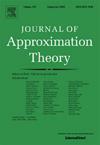多项式超群的对偶空间与哈氏度量
IF 0.6
3区 数学
Q2 MATHEMATICS
引用次数: 0
摘要
许多对称正交多项式 (Pn(x))n∈N0 都会在 N0 上诱发超群结构。哈氏度量是以 h(n)≔1/∫RPn2(x)dμ(x)≥1 加权的计数度量,其中 μ 表示正交化度量。我们观察到许多自然出现的例子都满足 h(n)≥2(n∈N) 这一显著特性。我们给出了充分的标准,并特别表明,如果(赫米特)对偶空间 N0 ̂ 等于整个区间 [-1,1],则 h(n)≥2(n∈N)。我们还研究了乘积的非负线性化(以及由此产生的谐波分析和函数分析)的作用。此外,我们还构建了两个 h(1)<2 的示例类型。第一种类型基于 Karlin-McGregor 多项式,N0̂ 由两个区间组成,在某种意义上可以选择 "最大";h 为二次增长。第二种类型依赖于强紧凑类型的超群;h 以指数形式增长,而 N0 ̂ 是离散的。本文章由计算机程序翻译,如有差异,请以英文原文为准。
Dual spaces vs. Haar measures of polynomial hypergroups
Many symmetric orthogonal polynomials induce a hypergroup structure on . The Haar measure is the counting measure weighted with , where denotes the orthogonalization measure. We observed that many naturally occurring examples satisfy the remarkable property . We give sufficient criteria and particularly show that if the (Hermitian) dual space equals the full interval , which is fulfilled by an abundance of examples. We also study the role of nonnegative linearization of products (and of the resulting harmonic and functional analysis). Moreover, we construct two example types with . To our knowledge, these are the first such examples. The first type is based on Karlin–McGregor polynomials, and consists of two intervals and can be chosen “maximal” in some sense; is of quadratic growth. The second type relies on hypergroups of strong compact type; grows exponentially, and is discrete.
求助全文
通过发布文献求助,成功后即可免费获取论文全文。
去求助
来源期刊
CiteScore
1.90
自引率
11.10%
发文量
55
审稿时长
6-12 weeks
期刊介绍:
The Journal of Approximation Theory is devoted to advances in pure and applied approximation theory and related areas. These areas include, among others:
• Classical approximation
• Abstract approximation
• Constructive approximation
• Degree of approximation
• Fourier expansions
• Interpolation of operators
• General orthogonal systems
• Interpolation and quadratures
• Multivariate approximation
• Orthogonal polynomials
• Padé approximation
• Rational approximation
• Spline functions of one and several variables
• Approximation by radial basis functions in Euclidean spaces, on spheres, and on more general manifolds
• Special functions with strong connections to classical harmonic analysis, orthogonal polynomial, and approximation theory (as opposed to combinatorics, number theory, representation theory, generating functions, formal theory, and so forth)
• Approximation theoretic aspects of real or complex function theory, function theory, difference or differential equations, function spaces, or harmonic analysis
• Wavelet Theory and its applications in signal and image processing, and in differential equations with special emphasis on connections between wavelet theory and elements of approximation theory (such as approximation orders, Besov and Sobolev spaces, and so forth)
• Gabor (Weyl-Heisenberg) expansions and sampling theory.

 求助内容:
求助内容: 应助结果提醒方式:
应助结果提醒方式:


